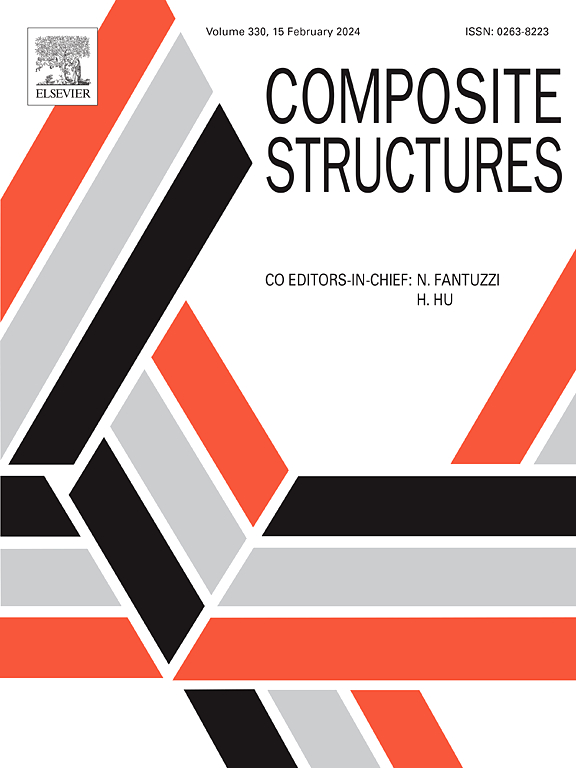单向热固性CF/环氧树脂与热塑性CF/PEEK复合材料钻削特性的比较研究
IF 6.3
2区 材料科学
Q1 MATERIALS SCIENCE, COMPOSITES
引用次数: 0
摘要
热塑性碳纤维增强聚醚醚酮(CF/PEEK)复合材料由于其优异的机械性能和可持续性,在高端设备中越来越多地被用作热固性碳纤维增强环氧(CF/环氧)复合材料的替代品。对于这两种复合部件,钻孔是制造过程中不可或缺的操作。为了区分两种复合材料的钻孔特性,本文对不同参数下的CF/环氧树脂和CF/PEEK单向钻孔进行了对比实验。考察了切屑形成、钻井温度、推力、孔损伤和尺寸精度等几个方面。特别考虑了纤维切割角度对出口和孔壁损伤的影响。结果表明,与CF/环氧树脂相比,由于PEEK具有更高的延展性和韧性,CF/PEEK可以产生连续切屑、更高的钻削温度、更高的推力和更小的损伤区域。然而,由于PEEK对温度敏感,CF/PEEK的孔壁亚表面损伤更严重,尺寸精度更差。因此,与CF/环氧树脂不同,在低进给时增加主轴转速不能改善CF/PEEK的孔质量。此外,两种复合材料的孔损伤分布与纤维切割角度密切相关。该研究为CF/PEEK的高性能加工提供了指导。本文章由计算机程序翻译,如有差异,请以英文原文为准。
A comparative study on drilling characteristics of unidirectional thermosetting CF/epoxy and thermoplastic CF/PEEK composites
Thermoplastic carbon fiber reinforced polyetheretherketone (CF/PEEK) composites are increasingly utilized as substitutes for thermosetting carbon fiber reinforced epoxy (CF/epoxy) composites in high-end equipment, due to their superior mechanical performance and sustainable manufacturability. For both composite components, drilling is an indispensable operation in the manufacturing process. To distinguish the drilling characteristics of the two composites, comparative experiments on drilling unidirectional CF/epoxy and CF/PEEK under different parameters were conducted in this paper. Several aspects, including chip formation, drilling temperature, thrust force, hole damage, and dimensional accuracy, were examined. Particularly, the impact of fiber cutting angle on exit and hole wall damage was considered. Results demonstrate that due to the higher ductility and toughness of PEEK, CF/PEEK produces continuous chips, higher drilling temperatures, higher thrust forces, and smaller damage areas than that of CF/epoxy. However, CF/PEEK has more serious hole wall subsurface damage and poorer dimensional accuracy since PEEK is sensitive to temperature. Consequently, unlike CF/epoxy, increasing spindle speeds at the low feed cannot improve the hole quality of CF/PEEK. Moreover, the hole damage distribution of both composites is strongly associated with the fiber cutting angle. This study provides guidance for high-performance machining of CF/PEEK.
求助全文
通过发布文献求助,成功后即可免费获取论文全文。
去求助
来源期刊

Composite Structures
工程技术-材料科学:复合
CiteScore
12.00
自引率
12.70%
发文量
1246
审稿时长
78 days
期刊介绍:
The past few decades have seen outstanding advances in the use of composite materials in structural applications. There can be little doubt that, within engineering circles, composites have revolutionised traditional design concepts and made possible an unparalleled range of new and exciting possibilities as viable materials for construction. Composite Structures, an International Journal, disseminates knowledge between users, manufacturers, designers and researchers involved in structures or structural components manufactured using composite materials.
The journal publishes papers which contribute to knowledge in the use of composite materials in engineering structures. Papers deal with design, research and development studies, experimental investigations, theoretical analysis and fabrication techniques relevant to the application of composites in load-bearing components for assemblies, ranging from individual components such as plates and shells to complete composite structures.
 求助内容:
求助内容: 应助结果提醒方式:
应助结果提醒方式:


